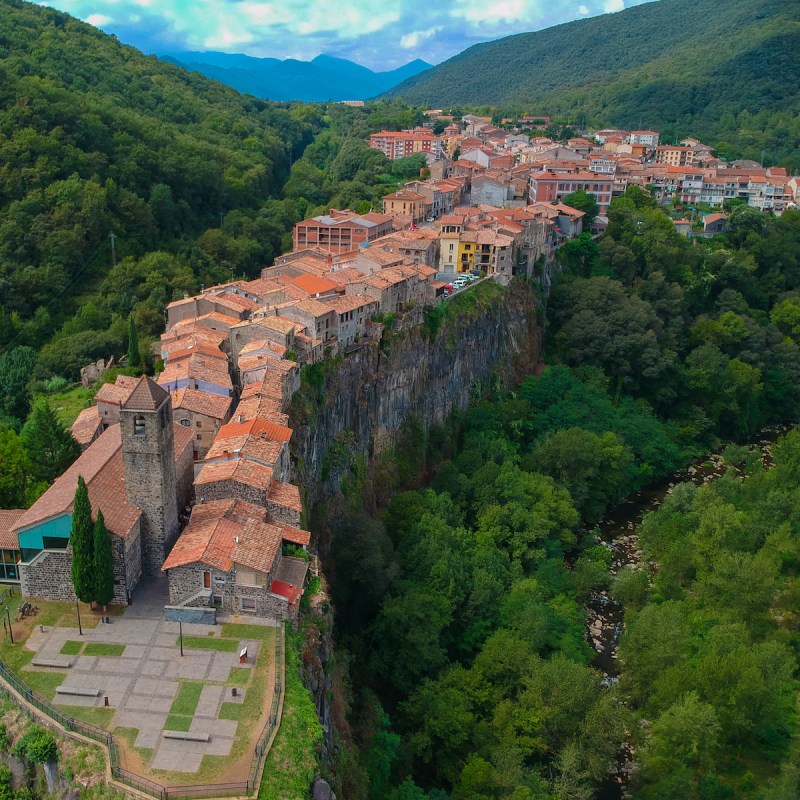
Note: The Travel Awaits team regularly updates content to provide the latest, and most accurate information to our readers. The updated content in this article may not reflect the views or opinions of the original author.
Videos by TravelAwaits
There’s a reason why Castellfollit de la Roca is one of the most photographed towns in Spain. The town, which is more than 1,000 years old, appears to be perched precariously on the edge of a 164-foot-high cliff. What’s more, the basalt cliff’s edge is very narrow, so the town’s houses stretch along the edge of the cliff in a long line.
Castellfollit de la Roca, Spain – A Tiny Village Popular Among Photography Buffs
The Cliff’s Formation
Castellfollit de la Roca is a municipality in the La Garrocha region, in the province of Girona. It is part of the judicial district of the neighboring town of Olot.
As is usually the case when towns are set in breathtaking spots, the location is a result of unique geologic activity. In this case, the cliff’s formation is due to lava flow — or more accurately, two overlapping lava flows.
The basaltic ridge Castellfollit de la Roca sits on was formed when two lava flows converged. First, approximately 217,000 years ago, lava flow came from volcanoes in the Batet de la Serra area, near Olot, Fascinating Spain explains. The other lava flow came from volcanoes near San Juan les Fonts approximately 192,000 years ago.
A Picturesque Village

This amazing European destination that feels like time stood still, with a population of 961, has narrow streets that “still carry the characteristics of its medieval origin, and the city center features ramparts that fortified the town during the civil war,” Atlas Obscura explains.
Castellfollit de la Roca is renowned for its dramatic setting atop a sheer basalt cliff, overlooking the Fluvià River. Its unique geological formation, coupled with its charming medieval architecture, creates a picturesque scene that attracts visitors seeking both natural beauty and historical intrigue.
“Many houses and streets in the city center are also built of the dark, volcanic rock that serves as a pedestal for the town,” the article continues. “The main street of Castellfollit winds through the entire town, narrowly pressed between houses on both sides, straining to remain on the cliff face.”
Adding to the town’s beauty are two rivers — Fluvià and Toronell — one on each side of the cliff. As if that isn’t enough, the city is known for its beautiful sunsets, as the sun’s rays illuminate the rocky cliff.

Sites To See
Once at Castellfollit de la Roca, there are two landmarks that simply must be seen in person.
The first is the San Salvador church, which is located at one end of the cliff. First built in the 13th century, the church has a square bell tower and has openings on each side. The bell tower is crowned by a dome decorated with small pilasters. It still preserves several reused basalt ashlars and a late Romanesque window, Fascinating Spain explains.
The second site to visit is the clock tower, located in Sant Roc Square, where the town hall is also located. The top of the clock tower features a clock and its bell tower. A fountain sits near the clock tower’s base.

The Local Cuisine
The Garrotxa volcanic area’s hearty gastronomy is famous for its local ingredients such as Sant Pau beans and wild mushrooms. There are a small handful of traditional restaurants in Castellfollit de la Roca that offer jaw-dropping views you’ll struggle to find elsewhere.
Foodies will also enjoy a visit to the El Museu de l’Embotit dedicated to Catalan charcuterie. You can retrace the history of meat curing in Spain and sample artisan-cured meats and sausages.
The Girona Region Is Easy to Explore
The village is often visited as part of a day trip to the Girona region and the Catalan countryside. The historic town of Sant Joan les Fonts seamlessly blends centuries-old architecture and breathtaking hiking trails. Olot serves as the capital of the Girona region while Besalú is renowned for its historic bridge and well-preserved medieval architecture.
The Views Are Fantastic
If the view of the town is impressive, so too is the view you can enjoy from standing at the Josep Pla Square viewpoint. Not for the faint-hearted, the 160-meter sheer drop that stands at the end of the village opens up onto Fluviá and Toronell Rivers beneath and you can soak up some breathtaking views of the valley down below.
Know Before You Go
One of the most picturesque villages I’ve visited, Castellfollit de la Roca is 5 miles away from Olot. Buses run to Castellfollit de la Roca from Girona (about 30 miles away) and from Barcelona (about 75 miles away).
To visit Castellfollit de la Roca from the USA, fly to Barcelona–El Prat Airport in Spain. From Barcelona, you can drive or take a bus or train to Castellfollit de la Roca
FAQs
Do People Still Live in Castellfollit de la Roca?
Yes, about 1,000 residents live among the narrow streets of Castellfollit de la Roca, one of the smallest towns in Catalonia, Spain. The historic old town, perched on top of a cliff ledge between two rivers, dates back to the Middle Ages.
What Is the History of Castellfollit de la Roca?
Castellfollit de la Roca is a more than millennia-old town. It has its origins in the Middle Ages and consists of squares and dark, narrow streets. The houses are mostly made from volcanic rocks.
Where in Castellfollit de la Roca Can I Get the Best Views?
The Josep Pla Square viewpoint is right on the edge of the cliff and offers stunning landscapes and views. Sant Salvador Church and, above all, the village’s natural surroundings can be fully appreciated from the Josep Pla Square viewpoint.
Why Is Castellfollit de la Roca So Special?
Set between the Fluviá and Toronell Rivers, Catalonia Castellfollit de la Roca is one of the most picturesque villages in the whole of Spain. The old church and houses cling to the top of a spectacular basalt rock face, which has become one of the most widely recognized images of the region.
What Are Castellfollit de la Roca’s Most Beautiful Attractions?
Its most noteworthy attractions are Sant Salvador Church, which dates from the 13th century, and the village’s gorgeous natural surroundings. A trip to the Cós Sanctuary is also strongly recommended.
